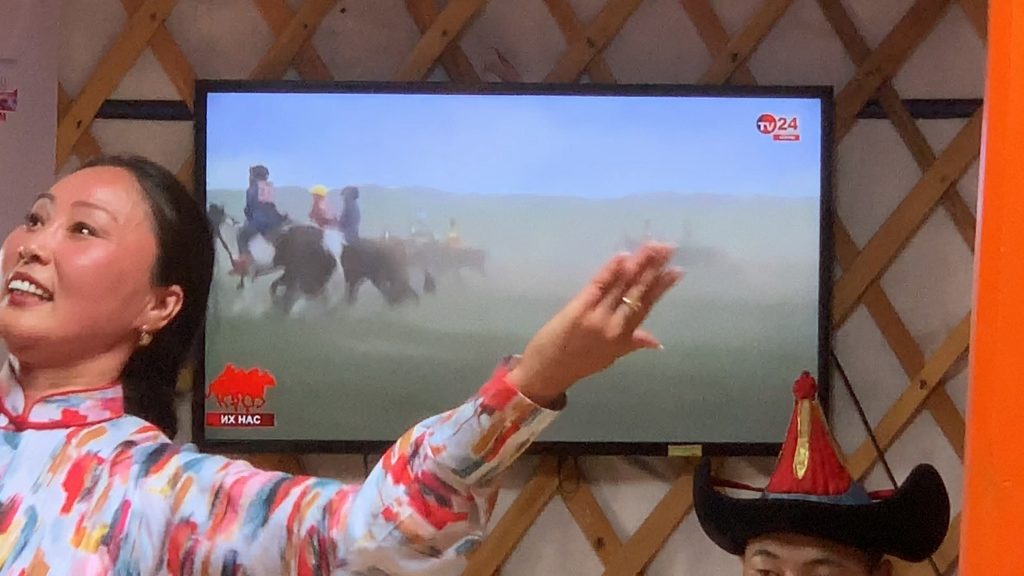(For English, Please Scroll Down)
移民敘事-台灣X蒙古交流篇
時間:2019.10.27 (日) 1-9 pm
地點:台北當代藝術中心
本活動免費對外開放。
歌德學院於 2018 年邀請九位來自東亞及東南亞的策展人,以「移民敘事」為題,於韓國與德國進行了系列的交流座談。據此,受邀策展人委任藝術家製作新作,部分作品於蒙古烏蘭巴托的新媒體藝術節(2019年六月二十一日至七月七日)展出,並將於韓國光州亞洲文化中心(2019年十一月二十三日至2020年二月二十三日)展出。
遷徙與移動,是蒙古遊牧民族的生活常態,也是人,動物與自然並存,生生不息的生態循環。但在傳統的遊牧生產方式與快速移植而入的現代化生產與都市生活中,蒙古的社會衝突與世代價值彼此拉鋸。在以現代化為單一價值的社會裡,關於移民,蒙古是否能我們提供另一種敘事的角度?
台灣受邀策展人鄭美雅,以移民為議題,邀請台灣四位藝術家:蔡佳葳,王福瑞,許哲瑜及林怡君前往蒙古進行調研與創作,及三位蒙古文化工作者 Gerelsuren Ganbold,Ikhbayar Urchuud 及 Byambanyam Urtnasan 來台交流參訪。本次的一日發表會,將呈現本次交流計畫的成果,包括台蒙創作者之間對兩地文化脈絡的考察,以及台灣藝術家新作放映與蒙古短片選映。
1:00-6:30 pm : 藝術家分享:許哲瑜,王福瑞,Ikhbayar Urchuud, Byambanyam Urtnasan, and Gerelsuren Ganbold,主持人:鄭美雅
7:00-9:00 pm :「移民敘事」影展及開幕酒會:選映作品藝術家:林怡君,Otgon-Erdene Erdene-Ochir, Oyuzanzaya Amartuvshin, Bat-Amgalan Lkhagvajav and Zulaa Urchuud
創意空間的結夥
Gerelsuren Ganbold
蒙古藝術協會(ACM)致力於支持蒙古的藝術文化發展及文化保存的機構,Gerelsuren Ganbold是蒙古藝術協會(ACM)的藝術經理。透過 ACM 的幾個大型項目的執行,如紅色蒙古包創意空間,烏蘭巴托新媒體藝術節(UBUMAF),以及烏蘭巴托國際電影節(UIFF),以及這些項目的執行,Gerelsuren 協助了蒙古本地藝術環境的成長,促進了蒙古本地與全球藝術工作者╱機構的交流與結盟。本次講座,她將介紹 ACM 主要的長期計畫,藉此與台灣的文化工作者與機構開啟初步的連結行動。
蒙古音旅
王福瑞
在高速都市化與劇烈的經濟變動中,蒙古人的生活方式隨之改變。大自然的遊牧生產被工廠與礦場取代,移居到城市與城市邊緣定居的蒙古人,面對新的生存環境的挑戰。聲音藝術家王福瑞於駐留蒙古期間,採集了大自然的聲音與都市工業噪音,並擷取烏蘭巴托都市空氣中 PM2.5 含量指數,將數據轉換成聲音的波動頻率。使用 convolution 的聲音合成,將大自然與都市的聲音交互合成,織構出涵蓋了蒙古生態與當下生命狀態的複雜音景。
本次的發表,王福瑞將呈現他所採集的自然聲音與工業噪音,說明其聲音轉化的創作思路與聲音轉化的技術手法。他並邀請觀眾在全黑的環境中,透過聽覺,感受蒙古在傳統到當代的音景變化。
作品進行中:蒙古觀察
許哲瑜
哈斯台國家公園(Hustai National Park)是一片五百平方公里的土地,人與動物在這裡立下了互不干涉的契約。有點像周潤發演出的黑幫電影《和平飯店》,或是基努李維《捍衛任務》中的大陸飯店,在契約指定的場域,即使是仇家也不能開火交戰。
在哈斯台國家公園這個契約地共有51種哺乳類動物。契約地是絕對的自由之地,很難找到比這裡更自由的動物。即使當地人遇見最愛吃的地鼠,也不能動牠半根寒毛。相對的,這裡的動物們結黨成派,有時為了領地戰鬥,人類也不得干涉、或救援受傷的動物。若有動物死於此,也不能移動屍體,只能任由禿鷹啃食。
不過,這片契約地裡雖然有許多「野馬」,但「家馬」不得進入,因為「家馬」是依人類而生存,無法遵守契約地中人與馬互不干涉的守則。包含「野馬」在內。此外,每一隻哺乳類動物都有編號,科學家們每日觀察與追蹤牠們。每日下午喜歡去的地方,死對頭是誰,誰是同性伴侶。只有少數的動物擁有名字,只要有任何人捐一定數目的錢給契約地,捐贈者就可以指定一隻動物,替牠取名字。
這片土地就好像動物版的楚門的世界,而藝術家以這片土地為靈感發想,進行持續中的創作計畫。
最後的移民:記憶的認同
Byambanyam Urtnasan
蒙古人是遊牧民族。從一地到另一地的遷徙只是他們的日常生活。在廣大的中亞地區,從第一個遊牧民族的出現,到遊牧帝國的建立,人們為了放牧牲畜,一直定期地移動遷徙。然而,因戰爭與政治,而非為了生產所出現的遊牧遷徙,使蒙古人在近代歷史中產生了新的認同。Byambanyam Urtnasan 的研究計畫是透過訪談,在當代蒙古人尚保留的記憶中,摘錄出當代的一些歷史事件。這個計畫中,代表著蒙古近代的四次大規模移民的受訪者,(蒙古的 Khalmik 族到蘇俄,Deed 族到中國,Buryat 族到蘇俄,以及內蒙古人到台灣),回憶了先祖的遷徙移民。因此,這些訪談內容的材料,也可以稱為是「移民記憶」。
蒙古藝術電影的短篇介紹
Ikhbayar Urchuud 依可巴雅‧烏爾丘德
作品屢獲獎項肯定的依可巴雅‧烏爾丘德(Ikhbayar Urchuud)不僅身兼電影製片與媒體藝術家等多重身分,亦是推動蒙古實驗電影製作發展的開拓者,與蒙古電影學院(Mongolian Film Institute)的共同創辦人。自2013年以來,他除了指導電影拍攝之外,也持續擔任蒙古電影學院主辦的〈阿爾坦哈利斯國際電影節〉(MFI Altan Khalis International Film Festival)的策展人。烏爾丘德目前在「蒙古廣播和媒體藝術學院」(School of Broadcasting and Media Arts of Mongolia)擔任教職。在本次講座中,他將討論個人的藝術生涯,以及蒙古藝術電影與實驗電影的發展。此外,烏爾丘德還將放映四部精選短片,短片內容涉及蒙古人民遷徙的諸多面相,及其對當代蒙古社會和身份認同的影響。
作為一種即興與準備的哲學
林怡君
蒙古人的家居建築:蒙古包,是既私密又公共的空間,它是蒙古人日常作息的方位座標,也是其社會關係的空間表現。蒙古包體現了蒙古人在自然間棲居的建築方法,在此,自然光決定了每日的工作日程,而人的活動與自然環境的痕跡,也一一被收納進來。它說明了一種有別於理性(固定不變)與標準化的空間認識系統:人對自然環境的感知與在自然中的生產,致使人與自然的關係,建築與自然的關係恆常地變動,使人必須不斷地重新定位空間。因此,變動,是蒙古空間定位系統的基礎。
藝術家以個人短暫的實地著地經驗為出發,嘗試在蒙古的當代生活中尋找與收集各種顏色的身影,並將色彩與方位系統進行聯繫。關於這樣的隨機地、直面地、凝視地、測不準地觀看與遇見,或許可以提供得以擴充且不被定義限制的方法,用以檢視╱呈現遷移與定居間的衝突、以及快速現代化與都市化的發展歷程。這樣的色彩方位系統,並非是為指路,而是暗示方向感正在重置的過程。影片中,所包含的幾種顏色分別是緩衝(黃色)、節奏(藍色)(綠色)、夢與建設(白色)、資本位移(紅色)、以及忽視(黑色)。
移民敘事短片放映單元
《失落的時間》(Lost Time, 2019) – 奧特貢-埃爾德內埃爾德內-奧奇爾(Otgon-Erdene Erdene-Ochir)
《失落的時間》是關於一對父子的故事。兩人原先住在鄉間,兒子後來獨自搬到首都生活。多年後,當父親的決定去拜訪兒子。這部電影講述了遷徙如何導致身份認同和人際關係的轉變。
《帆船石╱自走石》(Sailing Stone, 2013) – 奧尤贊紮亞·阿馬圖夫申(Oyuzanzaya Amartuvshin)
這部短片述說了一名女子的精神朝聖之旅。為了踏上這段旅程,女子不得不做出取捨。本片在2013年蒙古〈阿爾坦哈利斯國際電影節〉上榮獲最大獎項肯定。
《精彩飛行》(The Wonderful Flight, 2016) – 貝特-阿姆加蘭·利卡瓦亞夫(Bat-Amgalan Lkhagvajav)
時值1996年,一架美國軍機飛離蒙古前往日本—在我們聽到的每一個悲傷故事的背後,都有一個我們聽不見的美好故事。本片榮獲2017年蒙古〈阿爾坦哈利斯國際電影節〉「最佳蒙古敘事短片獎」(Best Mongolian Narrative Short Film Award)。
《烏蘭巴托化》(Ulaanbaatarization, 2017 – 祖拉‧烏爾丘德(Zulaa Urchuud)
二十世紀70年代,都會化的市民心態在社會主義時代的烏蘭巴托市開始萌芽,過去曾經習慣遊牧生活方式的人民必須重頭開始適應城市的生活和環境。這種從遊牧生活方式到城市化生活方式的轉變,持續影響著蒙古人的思想與心態。本片為2017年蒙古〈阿爾坦哈利斯國際電影節〉、德國〈奧布斯庫拉電影節〉(Obscura Film Festival)官方入選影片,同年受邀在義大利威尼斯舉行的〈烏蘭巴托化〉展覽中放映,2019年本片並入選瑞士〈盧卡諾影展〉的(Locarno Film Festival)「開門放映」單元(Open Doors Screening Section)。
本計劃由游擊工作室與歌德學院共同策辦,台灣文化部贊助。台北當代藝術中心協辦。
Migration Narratives – Taiwan x Mongolia Cultural Exchange
Date: Sun, 27 October, 2019. 1:00-9:00 pm
Venue: Taipei Contemporary Art Centre (TCAC)
This event is free of charge and open to the public
1:00-6:30 pm: Artist presentations by Hsu Che Yu, Ikhbayar Urchuud, Fujui Wang, Byambanyam Urtnasan, and Gerelsuren Ganbold
Moderator: Meiya Cheng.
7:00-9:00 pm: Opening reception and film screenings on migration narratives: works by Lin Yi Chun, Otgon-Erdene Erdene-Ochir, Oyuzanzaya Amartuvshin, Bat-Amgalan Lkhagvajav and Zulaa Urchuud.
In 2018, Goethe Institute invited curators from 9 countries in East and Southeast Asia to explore the topic of migration through seminars and workshops held in Germany and Korea, leading to newly commissioned works by participating artists and exhibitions in IMF Ulaanbaatar, Mongolia (Jun. 21st –Jul. 7th) and ACC, Gwangju, Korea (Nov. 23rd 2019-Feb. 23rd 2020).
Migration and movement are endemic to the lifestyle of Mongolian nomads, as is the coexistence of human beings alongside animals and nature in a symbiotic ecological cycle. But, as the traditional nomadic lifestyle adapts to modernized modes production and urban living, many of Mongolia’s social issues and generational values are being pulled in a tug-of-war. In societies dictated by the values of modernization, how can Mongolia offer us another perspective into the narrative of migration?
Meiya Cheng, independent curator, was invited by Goethe Institute to be part of this project. She commissioned four Taiwanese artists including Charwei Tsai, Fujui Wang, Hsu Che Yu and Lin Yi Chun to produce new works related to migration in Mongolia, and invited three Mongolian cultural workers, Gerelsuren Ganbolad, Byambanyam Urtnasan,and Ikhbayar Urchuud to come to Taiwan to conduct research. This one-day event offers insight into the intercultural experience, exchange and professional practices of artists, filmmakers and art practitioners from Mongolia and Taiwan.
Building Partnerships Through Creative Space
Gerelsuren Ganbold
Gerelsuren Ganbold is an arts manager at the Arts Council of Mongolia (ACM), an institution dedicated to supporting the development of Mongolian arts and culture and the preservation of cultural heritage. Through projects such as the Red Ger Creative Space, the Ulaanbaatar International Media Arts Festival (UBIMAF), and the Ulaanbaatar International Film Festival (UIFF), she has been involved in fostering local growth in the Mongolian art scene, as well as creating an international exchange and allegiance with institutions and artists from across the globe. In her presentation, she will introduce the main long-term projects of ACM, thereby taking the first step towards fostering a connection with Taiwanese cultural workers and institutions.
Mongolian Sound Tour
Fujui Wang
The Mongolian way of living has been changing in response to rapid urbanization and dramatic economic shifts. Factories and mines have replaced the nomadic lifestyle of living off the land, and Mongolians who have settled in and around cities face new challenges in adjusting to their environment. During his stay in Mongolia, sound artist Fujui Wang collected sounds from nature and urban industrial settings, as well as the PM 2.5 air quality index from Ulaanbaatar’s atmosphere, then converted the data into sound waves. The natural and industrial sounds interact with each other through a process of convolution, weaving together to compose a complex soundscape of contemporary Mongolian life.
In his presentation, Fujui Wang will share his collections of natural and industrial sounds, and explain the technical and creative processes that go into transforming these soundscapes. He will also invite the audience into a completely dark space where they will be asked to engage their sense of hearing in order to experience the progression from traditional Mongolian soundscapes to contemporary ones .
Work in Progress: Mongolian Report
Hsu Che Yu
Covering 50,600 hectares, Hustai National Park is an area where human beings and animals have entered into a contract to keep their lives to themselves—similar to that of the 1995 Hong Kong movie Peace Hotel starring by Chou Yun-Fat, and the more recent “Continental Hotel” in the John Wick franchise starring Keanu Reeves—within the designated area, even enemies and foes have to cease their fire.
Though the shrewmouse is the locals’ favorite delicacy, in Hustai National Park, no one should lay a hand on them. Animals in the park are gregarious, and they will fight for their own territory. No human being should try to mediate a fight or to save any injured animal. If an animal should die, no one is allowed to move the carcass—just leave it for vultures to feast upon.
On this contracted land live many wild horses. No domesticated horses are allowed in the park due to the fact that their survival relies on humans, and their presence would violate the contract’s term that humans and horses should not have any sort of contact. Local scientists once told me that there are only two kinds of horses in this world—either feral or domesticated—and they do not share the same genes. In one case, the local scientists had to put down a pony with mixed genes in order to secure the genetic lineage of the wild horses.
Including the wild horses, there are 51 species of mammals on this contracted land. No animal enjoys more freedom than those within this promised land. Each mammal has its own identification number for scientists to keep track of them. Where do they like to go in the afternoon? Which animals are arch enemies? And which of the animals are same-sex couples? Nothing escapes the scientists’ eyes. Only few animals are named, but if someone were to donate a certain amount of money to the contracted land, the donor would be able to name an animal of their choice.
This land is the animal version of the movie The Truman Show, and it has inspired me to launch my project.
The Last Migration: The Identity of Memory
Byambanyam Urtnasan
Mongolians are nomads. Moving from one place to another is just a part of their daily life. They have been living by moving regularly from one place to another in order to raise their livestock across Mongolia’s vast territory since the appearance of the first tribes in Central Asia until the establishment of the nomadic empire. But unlike nomadic movements for the sake of livestock, migrations triggered by political issues and war have created a new identity for Mongolians in the history of the modern world. The goal of our project is to extract these sorts of historical events from how they are retained in current memory. In this project, people who represent Mongolia’s Four Great Out-Migrations (Khalmik mongols to Russia, Deed Mongols to China, Buryat Mongols to Russia, Inner Mongolians to Taiwan) recall the migrations of their ancestors. Thus, we can call these interviews ‘remembering from migration’.
A Short Introduction of Mongolian Art Cinema
Ikhbayar Urchuud
Award-winning filmmaker and media artist, Ikhbayar Urchuud is a pioneering forcebehind the development of experimental filmmaking in Mongolia. He co-founded the Mongolian Film Institute, and since 2013 he has been working as a director and a programmer of MFI Altan Khalis International Film Festival in Mongolia. Currently, he holds a teaching position at the School of Broadcasting and Media Arts of Mongolia.
In this presentation, he will discuss developments of Mongolian arthouse cinema,
experimental film, as well as his artistic career. In addition, Urchuud will screen a
selection of four short films that address different aspects of Mongolian migration, and its effect on contemporary Mongolian society and identity.
(On/Off) The Philosophy of Improvisation and Preparation
Lin Yi Chun
The ger is a common form of Mongolian housing architecture. It is a private space as much as it is a public one, and functions as the coordinate map to Mongolians’ work and life, and as a spatial representation of social relationships. The ger embodies the idea that Mongolians’ lives are closely tied to nature; each day the sun dictates the working schedule, and influences all other human activities. In this way, the ger offers us an example of a different concept of spatialization: one that is consistent and standardized. In Mongolia, humans’ sensitivity to nature and reliance on it have prompted populations to constantly relocate, re-coordinate, and reconceptualize space. The relationship between humans and nature, and consequently between architecture and nature, have never been fixed. Thus, variation is one of the foundations of the Mongolian concept of space.
Drawing from her short-term field work experience in Mongolia, the artist began her work by seeking out and collecting various colors and hues from within contemporary Mongolian life and linking these colors to a coordinate system. There’s a possibility that such random and contrived observations could somehow provide an expandable and undefinable method to examine and represent issues related to migration and habitation as well as the development of modern urbanization. Such a color-coded coordinate system would not be meant for pointing out the way, but instead to show that directional sensibilities are undergoing change. In the video footage, each color has its own connotation—buffer (yellow), rhythm (blue and green), dream and construction (white), capital displacement (red) and ignorance (black).
SHORT FILM SCREENING ON MIGRATION NARRATIVES
Lost Time (2019) – Otgon-Erdene Erdene-Ochir
Lost Time is a story about a son who used to live in the countryside, but then moved to the capital to live. After many years, his father decides to pay him a visit. This film encapsulates the shift in identity and interpersonal relationships as a result of migration.
Sailing Stone (2013) – Oyuzanzaya Amartuvshin
This short film is about a woman’s pilgrimage to the spiritual realm. However, in order to embark on this journey, there are some things she needs to leave behind.
This film was awarded the Top prize at MFI Altan Khalis International Film Festival 2013.
The Wonderful Flight (2016) – Bat-Amgalan Lkhagvajav
1996: An American military flight leaves Mongolia for Japan. For every sad story we hear, there is a bright story we don’t get to hear.
This film was awarded the Best Mongolian narrative short film award at MFI Altan Khalis International Film Festival 2017.
Ulaanbaatarization (2017) – Zulaa Urchuud
In 1970s Socialist-era Ulaanbaatar, Mongolian urban mentality took shape. People who were once accustomed to nomadic lifestyle had to adapt to the urban livelihood and environment. This change from the nomadic way of life to urbanized life continues to influence Mongolian people’s minds. Official selection of Altan Khalis International Film Festival 2017 and Obscura Film Festival, 2017, in Germany. Screened in an exhibition “Ulaanbaatarization” in 2017, Venice, Italy. Screened in Locarno Film Festival 2019 Open Doors Screening Section.
Project organized by Guerilla Workstation and Goethe Institute
Supported by Taipei Contemporary Art Center
Sponsor: Ministry of Culture, Taiwan

